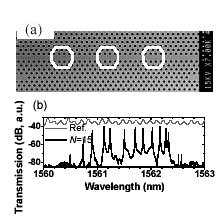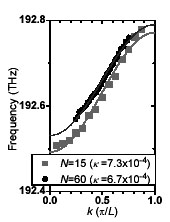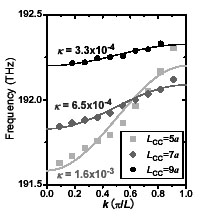@
Eiichi Kuramochi, Takasumi Tanabe, Hideaki Taniyama, and Masaya Notomi
Optical Science Laboratory
@A periodic chain of optical resonators (coupled resonator optical waveguide:
CROW) has been expected as a promising candidate of a slow light media
[1]. An ultrahigh intrinsic quality factor (Q)
of a resonator is required to achieve ultraslow group velocity (vg) and low propagation loss simultaneously. Recently, we have demonstrated
that such CROW is achievable on a Si photonic crystal (PC) platform besides
an advantage of ultra-small footprint (`3Êm@single resonator.)
@Figure 1(a) is a microscope image of a PC-CROW fabricated by electron
beam lithography (the number of the resonator: N=3.) A
locally width-modulated line-defect resonator [2] realized ultrahigh
experimental Q (1.2~106)[3].
Sharp peaks which corresponded to CROW modes were clearly observed in
transmittance measurements (Fig. 1(b).) Figure 2 shows dispersion of CROW modes
when the interval of the resonator (LCC)
was 7a (a: lattice constant=420nm.) Surprisingly, the dispersion of the
coupled resonator modes were fitted well by almost equal theoretically derived
cosine-function, which corresponded to very small coupling coefficient
k (`7~10-4), when N was changed from 5 to 60. The passing of light over 60 PC resonators
was achieved for the first time which successfully demonstrated advantage
of ultrahigh-Q. The
dispersion was controlled well by LCC
(Fig. 3) and the lowest k (3.3~10-4)
corresponded to very slow vg (`5~10-3c; c: the speed of light in vacuum.)
@This work is encouraging possibility of a PC-based CROW as a slow light
media.
[1] A. Yariv, et al., Opt. Lett. 24 (1999) 711.
[2] E. Kuramochi, et al., Appl. Phys. Lett. 88 (2006) 041112.
[3] T. Tanabe, et al., Opt. Express. 15 (2007) 7826.
 |
 |
 |
||||||||
|
|
|